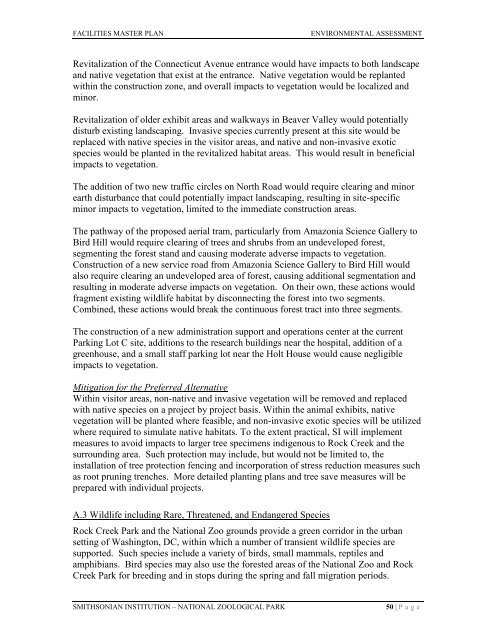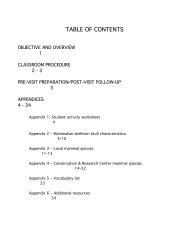facilities renewal master plan - National Zoo - Smithsonian Institution
facilities renewal master plan - National Zoo - Smithsonian Institution
facilities renewal master plan - National Zoo - Smithsonian Institution
Create successful ePaper yourself
Turn your PDF publications into a flip-book with our unique Google optimized e-Paper software.
FACILITIES MASTER PLAN ENVIRONMENTAL ASSESSMENT<br />
Revitalization of the Connecticut Avenue entrance would have impacts to both landscape<br />
and native vegetation that exist at the entrance. Native vegetation would be re<strong>plan</strong>ted<br />
within the construction zone, and overall impacts to vegetation would be localized and<br />
minor.<br />
Revitalization of older exhibit areas and walkways in Beaver Valley would potentially<br />
disturb existing landscaping. Invasive species currently present at this site would be<br />
replaced with native species in the visitor areas, and native and non-invasive exotic<br />
species would be <strong>plan</strong>ted in the revitalized habitat areas. This would result in beneficial<br />
impacts to vegetation.<br />
The addition of two new traffic circles on North Road would require clearing and minor<br />
earth disturbance that could potentially impact landscaping, resulting in site-specific<br />
minor impacts to vegetation, limited to the immediate construction areas.<br />
The pathway of the proposed aerial tram, particularly from Amazonia Science Gallery to<br />
Bird Hill would require clearing of trees and shrubs from an undeveloped forest,<br />
segmenting the forest stand and causing moderate adverse impacts to vegetation.<br />
Construction of a new service road from Amazonia Science Gallery to Bird Hill would<br />
also require clearing an undeveloped area of forest, causing additional segmentation and<br />
resulting in moderate adverse impacts on vegetation. On their own, these actions would<br />
fragment existing wildlife habitat by disconnecting the forest into two segments.<br />
Combined, these actions would break the continuous forest tract into three segments.<br />
The construction of a new administration support and operations center at the current<br />
Parking Lot C site, additions to the research buildings near the hospital, addition of a<br />
greenhouse, and a small staff parking lot near the Holt House would cause negligible<br />
impacts to vegetation.<br />
Mitigation for the Preferred Alternative<br />
Within visitor areas, non-native and invasive vegetation will be removed and replaced<br />
with native species on a project by project basis. Within the animal exhibits, native<br />
vegetation will be <strong>plan</strong>ted where feasible, and non-invasive exotic species will be utilized<br />
where required to simulate native habitats. To the extent practical, SI will implement<br />
measures to avoid impacts to larger tree specimens indigenous to Rock Creek and the<br />
surrounding area. Such protection may include, but would not be limited to, the<br />
installation of tree protection fencing and incorporation of stress reduction measures such<br />
as root pruning trenches. More detailed <strong>plan</strong>ting <strong>plan</strong>s and tree save measures will be<br />
prepared with individual projects.<br />
A.3 Wildlife including Rare, Threatened, and Endangered Species<br />
Rock Creek Park and the <strong>National</strong> <strong>Zoo</strong> grounds provide a green corridor in the urban<br />
setting of Washington, DC, within which a number of transient wildlife species are<br />
supported. Such species include a variety of birds, small mammals, reptiles and<br />
amphibians. Bird species may also use the forested areas of the <strong>National</strong> <strong>Zoo</strong> and Rock<br />
Creek Park for breeding and in stops during the spring and fall migration periods.<br />
SMITHSONIAN INSTITUTION – NATIONAL ZOOLOGICAL PARK 50 | P a g e

















